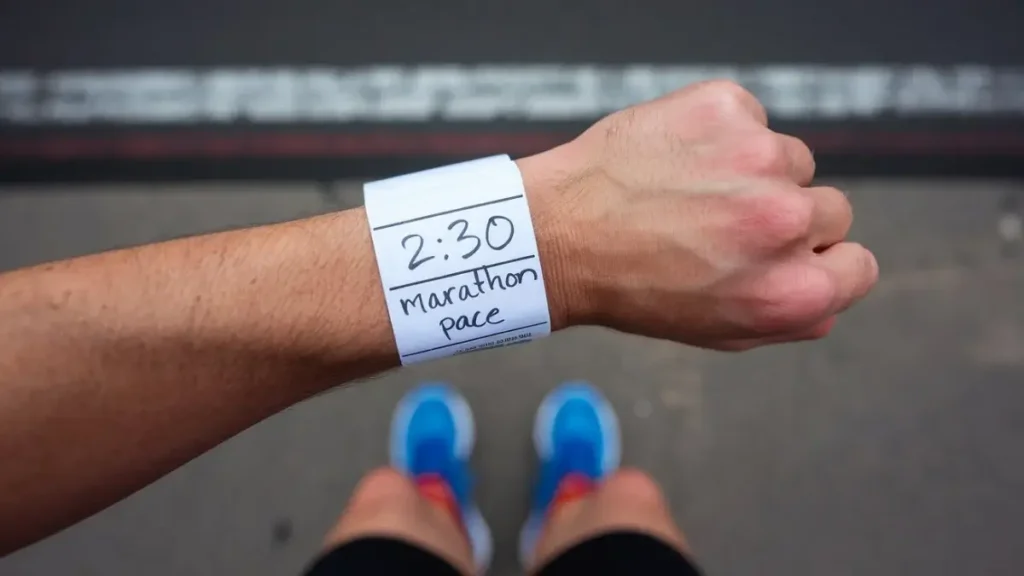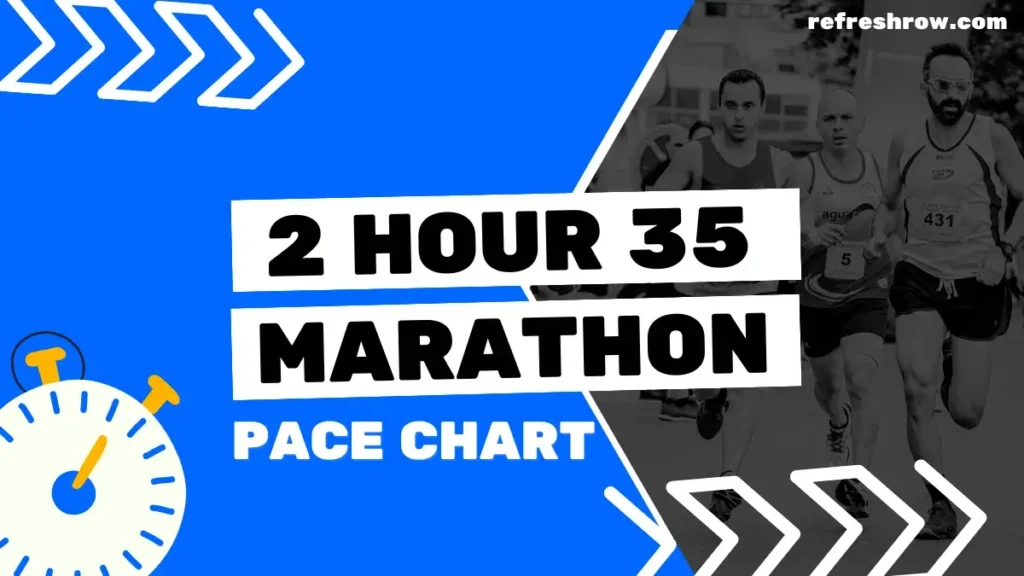To run a 4:15 hour marathon you need to run at a pace of 9:44 per mile or 6:03 per kilometer.
Following the splits below (and shaving off a second), you’ll run a sub 4:15 marathon.
I’d recommend aiming to run 1-2 minutes ahead of the split target time from 10 miles, as you’ll likely come up against crowding on race day.
4:15 Marathon Pace in Miles
| Mile | Split |
|---|---|
| 1 | 9:44 |
| 2 | 19:27 |
| 3 | 29:11 |
| 4 | 38:54 |
| 5 | 48:38 |
| 6 | 58:21 |
| 7 | 1:08:05 |
| 8 | 1:17:48 |
| 9 | 1:27:32 |
| 10 | 1:37:16 |
| 11 | 1:46:59 |
| 12 | 1:56:43 |
| 13 | 2:06:26 |
| 14 | 2:16:10 |
| 15 | 2:25:53 |
| 16 | 2:35:37 |
| 17 | 2:45:20 |
| 18 | 2:55:04 |
| 19 | 3:04:47 |
| 20 | 3:14:31 |
| 21 | 3:24:15 |
| 22 | 3:33:58 |
| 23 | 3:43:42 |
| 24 | 3:53:25 |
| 25 | 4:03:09 |
| 26 | 4:12:52 |
| 26.2 | 4:15:00 |
Download
4:15 Marathon Pace in KM
| KM | Split |
|---|---|
| 1 | 6:03 |
| 2 | 12:05 |
| 3 | 18:08 |
| 4 | 24:10 |
| 5 | 30:13 |
| 6 | 36:16 |
| 7 | 42:18 |
| 8 | 48:21 |
| 9 | 54:23 |
| 10 | 1:00:26 |
| 11 | 1:06:29 |
| 12 | 1:12:31 |
| 13 | 1:18:34 |
| 14 | 1:24:36 |
| 15 | 1:30:39 |
| 16 | 1:36:42 |
| 17 | 1:42:44 |
| 18 | 1:48:47 |
| 19 | 1:54:49 |
| 20 | 2:00:52 |
| 21 | 2:06:55 |
| 22 | 2:12:57 |
| 23 | 2:19:00 |
| 24 | 2:25:02 |
| 25 | 2:31:05 |
| 26 | 2:37:08 |
| 27 | 2:43:10 |
| 28 | 2:49:13 |
| 29 | 2:55:15 |
| 30 | 3:01:18 |
| 31 | 3:07:21 |
| 32 | 3:13:23 |
| 33 | 3:19:26 |
| 34 | 3:25:28 |
| 35 | 3:31:31 |
| 36 | 3:37:34 |
| 37 | 3:43:36 |
| 38 | 3:49:39 |
| 39 | 3:55:41 |
| 40 | 4:01:44 |
| 41 | 4:07:47 |
| 42 | 4:13:49 |
| 42.2 | 4:15:00 |
Download
Other Marathon Pace Charts
Targeting a different time?
Check out the Full Marathon Pace Chart in Miles or KM
Or select a specific finishing time below:
| 3:00 | 4:00 | 5:00 | |
| 3:05 | 4:05 | 5:15 | |
| 3:10 | 4:10 | 5:30 | |
| 3:15 | 4:15 | 5:45 | |
| 3:20 | 4:20 | 6:00 | |
| 3:25 | 4:25 | 6:15 | |
| 2:30 | 3:30 | 4:30 | 6:30 |
| 2:35 | 3:35 | 4:35 | 6:45 |
| 2:40 | 3:40 | 4:40 | 7:00 |
| 2:45 | 3:45 | 4:45 | |
| 2:50 | 3:50 | 4:50 | |
| 2:55 | 3:55 | 4:55 |
Training for a 4:15 Marathon
Is 4:15 a Good Marathon Time?
Well, what do the stats say?
Run Repeat conducted a study that contains 19,614,975 marathon results from more than 32,335 races across the globe, here is how a 4:15 marathon compares against age and gender for the races recorded:
| Overall | You’re faster than 60.1% of all runners. |
| Male | You’re faster than 49.5% of males. |
| Female | You’re faster than 74.3% of females. |
| <20 | You’re faster than 57.7% of under 20s. |
| 20-29 | You’re faster than 53.7% of 20-29 year olds. |
| 30-39 | You’re faster than 53.3% of 30-39 year olds. |
| 40-49 | You’re faster than 57.6% of 40-49 year olds. |
| 50-59 | You’re faster than 69.7% of 50-59 year olds. |
| >60 | You’re faster than 85.6% of over 60s. |
Training Runs and Paces for a 4:15 Marathon
To break a 4:15 marathon you’ll need to do some serious distance in your training, I recommend at least 15 miles (24km) per week.
You’re also going to need to make sure you’ve crossed off these milestones for other race distances:
- A 5k in 26:30 mins
- A 10k in 55:30 mins
- A half marathon in 1 hour 58 mins
Training Paces
| Pace | Mins per Mile | Mins per KM |
|---|---|---|
| Easy | 10:57 | 6:48 |
| Steady | 9:44 | 6:02 |
| 10k | 8:55 | 5:32 |
| 5k | 8:33 | 5:19 |
| 1 Mile | 7:56 | 4:58 |
Weekly Mileage Targets
| Target Mileage: | Gradually increase your weekly mileage from 25 miles (40 km) to a peak of 38 miles (61 km). |
| Incremental Increase: | Increase mileage by approximately 10% each week, with every fourth week as a recovery week where mileage is reduced by 20-30%. Make sure to taper for the last 1-2 weeks. |
Long Run Structure
| Total Distance: | Build up to long runs of 20-22 miles (32-35 km). |
| Segment Example: | First 5 miles (8 km): Easy pace, heart rate 140-150 bpm (approximately 11:30/mile or 7:09/km). Next 1 mile (1.6 km): Fast pace at 8:20/mile (5:10/km). Next 5 miles (8 km): Medium effort, heart rate around 160 bpm (approximately 9:20/mile or 5:48/km). Repeat: Repeat the segment twice (5 miles easy, 1 mile fast, 5 miles medium), you can taper the final 2 miles if required. |
Why This Works: Incorporating varied paces within long runs enhances lactate tolerance, which helps on race day when you’ve got to maintain pace despite feeling fatigued. By practicing surges during a run, you can build up your physical and mental resilience (lots of elite marathon runners use these strategies during their training)
Alternating Long Runs: Alternate between structured long runs (easy/fast segments) and easier long runs. For easier long runs, maintain a steady, comfortable pace throughout, focusing on mileage rather than speed to aid recovery.
Speedwork Sessions
| Short Intervals: | – 800m repeats at 4:05 per interval (5:04/km). – Aim for 6-12 repetitions with equal time for recovery. |
| Mile Repeats: | – 1 mile repeats at 8:20 per mile (5:10/km). – Aim for 6-12 repetitions with a 1-2 minute recovery jog. |
| Longer Intervals: | – 2 mile repeats at 8:30 per mile (5:17/km). – Aim for 5-8 repetitions with a 2-3 minute recovery jog. |
Recovery and Rest Days
| Rest Days: | You don’t need to incorporate rest days if you are using recovery runs, but I recommend taking 1 (or a max of 2) per week to allow your body to recover and prevent overtraining. |
| Easy Run Days: | Include 1-2 easy run days per week at a relaxed pace of 11:45/mile (7:18/km), covering 5-10 miles (8-16 km) per day. Try to keep your heart rate below 140 bpm on easy days to ensure proper recovery and aerobic development. |
My Tips to Run a Sub 4:15 Marathon
Use Pace Groups to Your Advantage
Many marathons offer pace groups, led by experienced runners who help participants stay on track for specific finishing times.
Joining a 4:15 pace group can be incredibly helpful, especially if you’re unsure about managing your pace over the full distance.
The pacers are there to do the mental math for you, so you can focus on running.
Plus, running with a group can provide much-needed camaraderie and motivation, helping you push through tough spots in the race.
Try Focusing on Cadence
As you aim for a 4:15 marathon, focusing on your running cadence—how many steps you take per minute—can be more beneficial than simply trying to increase your speed.
Aim for a cadence of around 170 to 180 steps per minute.
This helps you maintain a more efficient stride, reducing the risk of injury and improving your overall endurance.
Practice this during your tempo runs and intervals, and you’ll find that it naturally helps you keep a steady, comfortable pace on race day.
Practice Nutrition Timing
For a marathon with a target time of 4:15, timing your nutrition intake becomes critical.
Start fueling early in your run, even if you don’t feel like you need it yet.
I recommend taking in some form of calories every 45 minutes, whether it’s a gel, chew, or sports drink.
Practicing this during your long training runs will train your digestive system to handle fuel while running, preventing stomach issues and ensuring a steady energy supply when you need it most.
Practice Running at Race Effort, Not Just Race Pace
As you target a 4:15 marathon, it’s important to understand the difference between race pace and race effort.
While maintaining a specific pace is important, conditions on race day—such as hills, heat, or wind—might make sticking to a strict pace unrealistic.
Instead, train yourself to recognize what race effort feels like, especially during your tempo runs and long runs.
This way, you can adapt your pace based on the course and conditions while still running at an effort that will get you across the finish line in 4:15. This adaptability is key to a successful marathon.


Row Brown is the founder of Refresh Row. He is a keen marathon runner, his favorite being the London Marathon. He’s now set himself the mission of Running the Entire Length of Spain, which is scheduled for late 2024.


